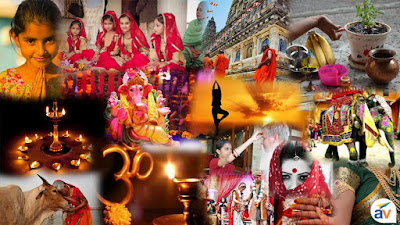Traditional myths and science (logic) behind customs and rituals
Traditions, customs and values are very integral part of human life which also adds an identity to the country he represents… Every country has its own way of values as pillars on which the whole social and cultural life is balanced… generally it is observed that things are followed as routine but the reasons behind it are unknown…
(Image ref : https://in.pinterest.com/pin/408983209891952809/)
दुर्लभं भारते जन्म - We should be grateful that we got birth in a country like India having a rich diversity of value-based culture… Indian culture and traditions have deep roots in the history of civilization… Since ages Indians are known to have strong followers of their traditions, customs and values… Having ten incarnations of God, India is known for its stout cultural and mythological background and intensified literature available to decode various beliefs and customs…
Indian culture and traditions are not like an open book where you read some part and blindly practice it daily to be proficient in it… Lot of things have been explained through stories and myths where one has to scratch his head and really think hard to come to a conclusion… Having said that, an intention behind doing this is to accept things logically so that what you practice is known to you thoroughly… 

(Image ref: https://in.pinterest.com/pin/855261785463280016/)
Taking an example of a typical Temple design and various elements can help us understanding and clarifying few of our (mis)beliefs and the design intentions…
Bell
Bell (also called ‘Ghanta’ in vernacular) is placed right at the entrance of all temples…
Myth: A person has to ring a bell right after entering a temple to inform God that he has arrived to meet him…
Science: So called ‘informing’ God that ‘I have come to meet you’ is an unnecessary dramatization of the concept of bell… It is scientifically proved that the reverberation sound waves when one rings a bell are responsible for positive vibes in human body… It is similar to the vibration sound of ‘Om’kar… It creates a positive energy and divine ambience which is must to forget physical word and get connected with the almighty…
(Imageref:https://www.google.com/search?q=temple+bell&sxsrf=ALeKk011oEVfkseLC2buh4MQVIw_mApKPA:1590660742116&source=lnms&tbm=isch&sa=X&ved=2ahUKEwiyt_eDqdbpAhXIcn0KHYnTA_8Q_AUoAXoECA0QAw&biw=1829&bih=894#imgrc=FG8lvk-ceHQHOM)
Sabha-mandap
It is a space typically planned in front of Garbh-griha…
Myth: Instead of entering directly in Garbh-griha one has to pass through Sabha-mandap to avoid crowd in Garbha-griha.
Science: Temples in India have been social centers for human civilization… Sabha-mandap in temples have played the role of holding people together… This is the place where entire villages come together to celebrate, to pray, to discourse, to exchange thoughts… so on and so forth… Temples have always made available a space which is common, divine, spiritual and most importantly without anyone’s ownership… Thus temples have been part of Indian civilization since ages…
(Image ref: http://www.shrivijayadurga.org/)
Garbha-griha
It is a place where an Idol of God is situated… It is the main enclosure of temple…
Myth: Garbh-grihas are very small as it is a private space of God…
Science: It is a space designed in temples where spiritual values are on high… A person is said to be very close with the God here… these spaces are purposely kept cozy to feel nearness with the God and a person can focus on his prayers… A very interesting design element of garbh-griha is its entrance door which is generally smaller than average human height… The reason behind it is that, when a person enters a Garbh-griha he has to inevitably bow down in front of an almighty… Garbh-griha heights are generally high to symbolize high magnitude of God…
(Image Ref: http://www.findmessages.com/closed-mantapa-with-lathe-turned-pillars-facing-the-sanctum-in-the-sadashiva-temple-at-nuggehalli-karnataka)
Idol
Praying to an Idol of Gods is a very common form of worshipping…
Myth: It is believed that we have restricted God in various Idols so that we can reach him easily…
Science: More than science, logically Rishis and saints made ‘humanification’ of God by shaping him in the form of human body… God is formless and shapeless, but if you need to concentrate on something you need to visualize an object to concentrate upon… This is how they made it simple for a common man to reach out to God…
Daan-patra
It is a box kept in a temple where donated amount is collected…
Myth: It is believed that the collected amount is used for maintenance of the temple…
Science: Temples are known to be the social as well as economical centers of villages since ancient times… It is true that donations are collected in these Dan-patras, but the intention behind this is very pure… The economical conditions of every villager cannot be same throughout the year… Depending on his way of livelihood, it is quite possible that some or other group of populaces is suffering due to natural calamities, accidents, death situations etc… Under such circumstances, donations collected from these Daan-patras are utilized as a helping hand to those primarily and secondary use is maintenance...
(Image ref: https://www.maavaishnodevi.org/donations.aspx)
Footware
While entering a temple it is obligatory to remove foot ware outside…
Routine: Foot ware carry lot of dust and unwanted things in clean area of temple…
Science: This cannot be classified as myth as there is a logic in this routine itself… however there is another side to it… The actual reason behind removing your foot ware outside explains that, one needs to put all his materialistic achievements outside and meet God… Whatever you have achieved in life i.e. power, position, post is because of the God-given strength… when you go and meet God has to be morally out of purest state of mind…
(Image ref: https://theculturetrip.com/asia/india/articles/15-things-you-should-never-do-in-india/)
Temples are known as the socio-economic centers in India… Lot of studies have been conducted over few aspects of human civilization… Without any surprise, logical reasons have been found behind the rituals and routines that have been followed over the years… It is a human tendency to blindly follow things which have been told by previous generations… Yes, that is one of the ways to keep your culture alive, but things have to be always logically cross-checked and followed… When your brain accepts it, it is easier to justify logic behind many such aspects of life… Failing in it may result into misconceptions and superstitions…
Fortunately, Indian customs and traditions have been given by extremely divine souls which are unobjectionable but the way it is followed has to be carefully done as we represent a culture which is purest form of worship… It is a duty of every responsible citizen of our country to critically understand the science and logic behind our way of worship…
Ar. Atul J. Phoujdar
(Asst. Prof. TSAP)
(For any details contact us)
Website: www.tsapmumbai.in
E-mail: tsap@thakureducation.org
Contact: 022-67308001/02
Whatsapp: +91-9833665446
Bibliography:
1. International Journal of Science and Research (IJSR)
Symbolism in Hindu Temple Architecture and
Fractal Geometry - 'Thought Behind Form'
Tanisha Dutta, Vinayak S. Adane
2. Reference reading of literature by Rev. Pandurangshastri Athavle
3. Hindu architecture











Nice read.
ReplyDeleteThank u...😊👍🏻
DeleteGood interpretation...
ReplyDeleteThanks...😊👍🏻
Delete